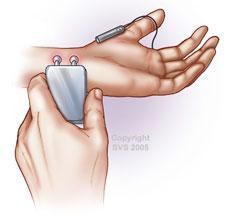Thoracic outlet syndrome (TOS) is an uncommon medical condition that happens when the nerves and blood vessels between the neck and shoulder are pinched and compressed between the collarbone and top rib. This area is called the thoracic outlet. TOS can cause arm and hand pain, numbness, weakness, and swelling.
The thoracic outlet is shaped like a triangle and is found at both sides of the body. When the thoracic outlet is working normally, the nerves and blood vessels of the arms are not damaged by being squeezed when a person uses their arms or turns their head.
With TOS, the nerves or blood vessels of the arms are pinched or squeezed and damaged. TOS can happen genetically if the clavicle bone, first rib bone, or another neck bone is too large or too narrow. TOS can also happen when the muscle in the thoracic outlet gets too big, such as with some sports players (baseball players or swimmers, for example) and in some people with jobs that require lifting their arms above their heads repeatedly (window washers, for example).
- Pain, numbness, tingling: You may feel pain, sometimes suddenly, in your neck or arms along with numbness and tingling in the arm and hand. Usually the pain gets worse when you lift your arms or with repetitive overhead motion.
- Swelling, blue discoloration, fatigue: Your arms and hands may be swollen and appear blue, and easily tire.
- Sores that resist healing: You may develop sores on your fingers that are slow to heal and could lead to gangrene
Role of Vascular Surgeon
Vascular surgeons are educated and trained in the diagnosis and treatment of TOS. It is important to consult with a vascular surgeon early when TOS is suspected as delays in care can lead to worse outcomes.
Diagnosis
There is no single test to diagnose TOS. A doctor will order several tests to ensure the patient isn’t suffering from a more common diagnosis of the arms, such as arthritis, muscle sprain, or pinched neck nerves.

Best results come from a combination of medical treatment and physical therapy. Specifics will vary depending on the source of the condition.
Nerve-related
- Specialized physical therapy and injections to relieve muscle spasm may resolve your symptoms.
- If symptoms are severe and persist and you are a good candidate for surgery, a procedure called thoracic outlet decompression is the next step.
- If surgery is not suitable for you or does not relieve your symptoms, you will want to consider ongoing medication to manage pain.
Artery-related
- If arterial compression is diagnosed, a surgery called thoracic outlet decompression is the next step. Depending on the damage to the artery, an arterial bypass may be part of this surgery.
Vein-related
- If arm swelling or a blood clot in the vein is due to thoracic outlet compression, thoracic outlet decompression is the next step.
- If there is a clot in the vein, you may be directed to have thrombolytic therapy.
- You may also benefit from some type of vein reconstruction: angioplasty, patch angioplasty, or venous bypass.
